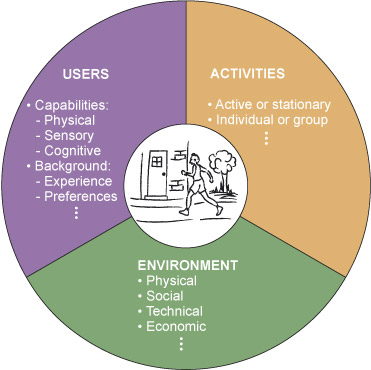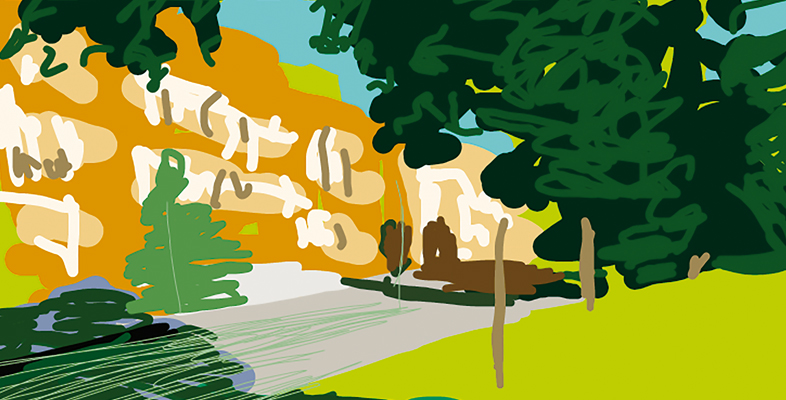Design context: The wider sociocultural, organisational and economic settings
The design context is more than the physical environment and can also be the wider organisational setting in which the product will be used, and also includes who is actually involved in the design process.
Although some interactive products may be designed in relative isolation, as the brainchild of an independent designer working outside any organisation or community, many are designed collaboratively within commercial organisations large or small. Sometimes design involves more than one organisation – for example, a consultancy company working with a client organisation or different subsidiaries of an international company. Just as individuals vary, organisations vary, and consequently the design process may vary.
Sociocultural: companies have different ways of working that may shape the design process. For example, companies offer varying degrees of flexibility to designers, some allowing individual teams to work as the equivalent of independent start-ups, others keeping interaction designers to strict roles within a larger structure. Some specify which tools should be used, others leave such choices to individual teams. Some divide development between different teams so that, for example, interaction design may be separated in time and scope from software engineering, or marketing may play a significant role in specifying products. Teams may come from very different perspectives; not just technical perspectives but also sociocultural ones. For example, many companies have development teams in different countries. At project level, sociocultural factors may influence ways of working (e.g. particular design, prototyping or evaluation methods; particular tools; particular team configurations), or constrain resources or determine the approvals processes.
Organisational: at the organisational level, a given interactive product may be conceived as part of a product line or portfolio, and therefore design choices may be influenced not just by the single product specification, but also by the styles, standards and technical infrastructure determined for the product line or portfolio. For example, a new interactive product may need to be compatible with other products, or may be constrained because some functionality is reserved for other products, or may be expected to make use of and interact with other products. There may be a company product strategy that either demands features of any new product, or specifies some design choices. Decisions about which products to develop may hinge on the proposed product’s fit with a company product strategy.
Economic: the size and wealth of a company may in turn affect the resources available for a given project – or the obligations of the project team. Resources may be evident in terms of the funding for the project, or in terms of the expertise that is readily available, or the tools and infrastructure that are readily available. More subtly, what drives the company may influence design priorities. For example, a charity developing an application to help disabled users access public services may have different priorities from a retail company developing a web-based shopping application. Moreover, external economic forces (such as the state of a national economy, particular government initiatives for development, or legislation that regulates industries and products) may influence interaction design at all levels, from funding to detailed design decisions.
Again, these categories are indicative of considerations that may arise as part of the wider production setting. We won’t be dealing with these in detail in this course, but they are a normal part of professional interaction design.
As we have seen, there are many aspects that are important to consider when designing interactive products, including people’s capabilities, their background, experiences and preferences, the activities they want to do, as well as their environment and social settings. Figure 19 summarises the aspects that you could consider, and the kind of questions that you ought to ask when you think about whom and what you design your interactive product for.

Activity 5 Thinking about the design context
In this section we have heard from two users about their use of a mobile technology to support their running. They provided insights into how to explore users’ characteristics and about the interplay between these, the activity in which they engage, and the wider environment for the activity and hence for the interaction.
Find a person who is willing to talk to you about a leisure activity; for example, a sport, or a game or any activity that is not directly related to work but rather with something they do for pleasure or their personal benefit.
Engage them in a brief conversation about their activity. Try to find out something about their capabilities (physical, sensory or cognitive), other background factors that are relevant, and the wider setting for the activity. Do they use technology? If so, what are they using the technology for? If not, have they considered whether technology might play a role?
Write this up as a short paragraph, and also write a short paragraph with your reflections on the issues involving this user, their activities and environment.
Discussion
I decided to talk to the son of one of my friends who has recently started running and who also recently got a new smartphone. I was interested to know which facilities he’d be using when running – if using them at all.
Peter is 17 years old and goes out for a run once a week with his friend Jo. He has done a bit of running before, but he has got into a more regular routine with his friend. He has tried using audio tracks for running but didn’t get on with this at all. He tried putting the phone on an armband, but this was hurting and got in the way of his arms moving during running. He thinks the armband was not the right size. He tried putting the phone in his trouser pocket but then it bangs against his leg the whole time during running. The wires from the earphones would also get tangled in his clothing and annoyed him when running. He now doesn’t use any technology at all and sees running as an activity to be completely free from everything. He is not particularly fussed about timings of his run or seeing the distance he has covered – he likes to feel whether he is getting fitter or not. He does use earphones for other activities, such as when he is at his desk and doing some easy homework task, where it is nice and calming to have some music in your head.
Reflections on users, activities and environment
This user emphasises physical aspects of the running activity that are problematic if technology in the form of a smartphone is used. He has tried several methods of carrying a device while running, and also using audio through earphones, but these all get in the way when running. It sounds as if this has been such a frustrating user experience that he has put the technology to the side completely. There is also mention of using earphones when doing calmer activities – such as doing homework – in an indoor environment. So the preference for earphones is very much influenced by the specific activity and the type of environment he is in.
